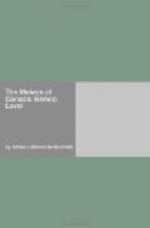The king, always well disposed towards the clergy of Canada, came to their aid again in this matter. He granted them an annual income of eight thousand francs, to be raised from his “Western Dominions,” that is to say, from the sum derived in Canada from the droit du quart and the farm of Tadousac; from these funds, which were distributed by the seminary until 1692, and after this date by the bishop alone, two thousand francs were to be set aside for priests prevented by illness or old age from fulfilling the duties of the holy ministry, and twelve hundred francs were to be employed in the erection of parochial churches. This aid came aptly, but was not sufficient, as Commissioner de Beauharnois himself admits. And yet the deplorable state in which the treasury of France then was, on account of the enormous expenses indulged in by Louis XIV, and especially in consequence of the wars which he waged against Europe, obliged him to diminish this allowance. In 1707 it was reduced by half.
It was feared for a time by the Sulpicians that the edict of 1679 might injure the rights which they had acquired from the union with their seminary of the parishes established on the Island of Montreal, and they therefore hastened to request from the king the civil confirmation of this canonical union. “There is,” they said in their request, “a sort of need that the parishes of the Island of Montreal and of the surrounding parts should be connected with a community able to furnish them with priests, who could not otherwise be found in the country, to administer the said livings; these priests would not expose themselves to a sea voyage and to leaving their family comforts to go and sacrifice themselves in a wild country, if they did not hope that in their infirmity or old age they would be free to withdraw from the laborious administration of the parishes, and that they would find a refuge in which to end their days in tranquillity in a community which, on its part, would not pledge itself in such a way as to afford them the hope of this refuge, and to furnish other priests in their place, if it had not the free control of the said parishes and power to distribute among them the ecclesiastics belonging to its body whom it might judge capable of this, and withdraw or exchange them when fitting.” The request of the Sulpicians was granted by the king.
It was not until 1680 that the Bishop of Quebec could return to Canada. The all-important questions of the permanence of livings and of the traffic in brandy were not the only ones which kept him in France; another difficulty, that of the dependence of his diocese, demanded of his devotion a great many efforts at the court. The circumstances were difficult. France was plunged at this period in the famous dispute between the government and the court of Rome over the question of the right of regale, a dispute which nearly brought about a schism. The Archbishop of Paris, Mgr. de Harlay, who had laboured so much when he was Bishop of Rouen to keep New France under the jurisdiction of the diocese of Normandy, used his influence to make Canada dependent on the archbishopric of Paris. The death of this prelate put an end to this claim, and the French colony in North America continued its direct connection with the Holy See.




